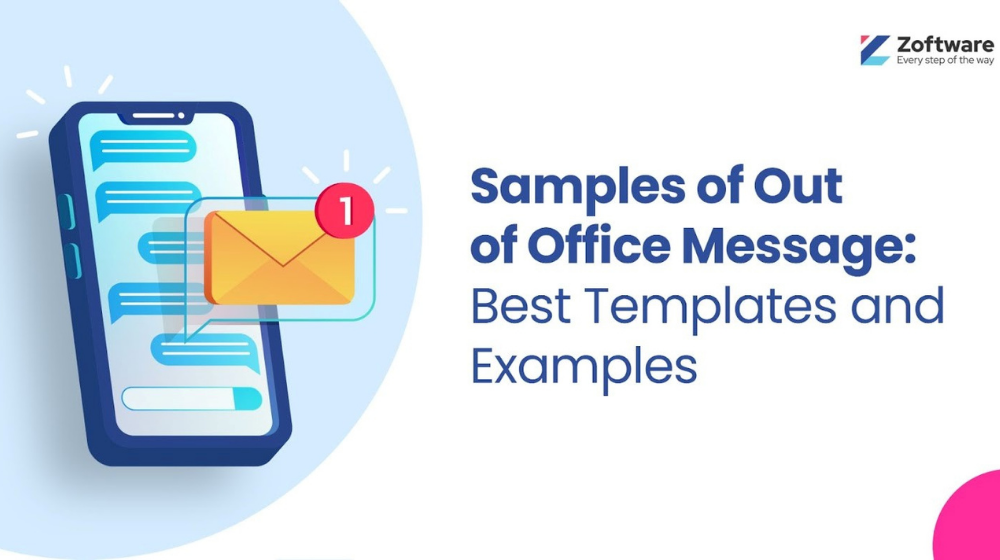Out-of-office messages are a crucial part of professional communication. They let colleagues, clients, and customers know you are unavailable and provide them with an alternative point of contact. Crafting a compelling out-of-office message can help manage expectations and maintain professional relationships.
Understanding the purpose of an out-of-office message is the first step in creating an effective one. Out-of-office messages should be informative, concise, and professional. They should provide:
- The dates of absence.
- An alternative point of contact.
- Any relevant information the recipient may need.
Out-of-office messages can also set boundaries and expectations for response times.
Professional out-of-office message examples can serve as a helpful guide when crafting your message. However, it is essential to tailor your message to your specific situation and audience. A generic message may come across as impersonal or unprofessional.
Key Takeaways
- Out-of-office messages are an essential part of professional communication.
- Effective out-of-office messages should be informative, concise, and professional.
- Professional out-of-office message examples can serve as a helpful guide, but it is essential to tailor your message to your specific situation and audience.
Understanding Out-of-Office Messages
Out-of-office messages are automated email replies sent to people who tried to contact someone unavailable. These messages help inform the sender that their email has been received and that a response may be delayed. Out-of-office messages are also helpful in providing information about when the recipient will be back and who the sender can contact in an emergency.
Out-of-office messages are crucial not only for people who are on vacation. They are also helpful for attending conferences, taking personal days, or working remotely. In any of these situations, an out-of-office message can help manage expectations and ensure that important emails are not missed.
When creating an out-of-office message, it’s essential to be clear and concise. The message should include the dates when the recipient will be out of the office, when they will return, and who to contact in case of an emergency.
Here are some tips for creating a compelling out-of-office message:
- Keep it short and to the point. The message should be easy to read and understand.
- Be professional. Even if the message is informal, it’s essential to maintain a professional tone.
- Include contact information. Ensure to include the name and contact information of someone who can help the sender in an emergency.
- Avoid giving too much information. While it’s essential to be clear about when the recipient will be back, it’s okay to provide too much detail about their whereabouts.
- Test the message. Before setting the message, make sure to test it by sending an email to yourself or a colleague.
By following these tips, anyone can create a compelling, out-of-office message to help manage expectations. Also, they ensure that important emails are noticed.
Professional Out-of-Office Message Examples
When you’re out of the office, setting up an out-of-office message that is professional and informative is essential. A well-crafted out-of-office message can help you maintain your professional reputation and ensure your colleagues and clients know of your absence.
Here are some professional out-of-office message examples that you can use as a guide when crafting your message:
Example 1
Subject: Out of Office Message
Thank you for your email. I am currently not at the office. I will not be available until [date of return]. During this time, I will have minimal access to the Internet. If your matter is urgent, please contact [name and contact information of colleague who can assist].
Best regards, [Your Name]
Example 2
Subject: Out of Office Message
Thank you for your email. I am currently not at the office and will not be available until [date of return]. During this time, I will not have access to email. I will respond to your message as soon as possible upon my return.
Best regards, [Your Name]
Example 3
Subject: Out of Office Message
Thank you for your email. From [date of leave] onwards, I will not be available in the office. As a result, I may only have limited access to emails. If you have an urgent issue, please contact [name and contact information of colleague who can assist]. Otherwise, I will respond to your email when I return to the office.
Best regards,
[Your Name]
Example 4
Subject: Out of Office Message
Thank you for your email. I am currently not at the office and will not be available until [date of return]. During this time, I will have limited access to the Internet. If your matter is urgent, please contact [name and contact information of colleague who can assist]. Otherwise, I will respond to your message as I return.
Best regards, [Your Name]
Example 5
Subject: Out of Office Message
Thank you for your email. I am currently not at the office and will not be available until [date of return]. During this time, I will not have access to email. If your matter is urgent, please contact [name and contact information of colleague who can assist]. Otherwise, I will respond to your message when I return.
Best regards, [Your Name]
Example 6
Subject: Out of Office Message
Thank you for your email. I am currently not at the office and will not be available until [date of return]. During this time, I will have limited access to the Internet. If your matter is urgent, please contact [name and contact information of colleague who can assist]. Otherwise, I will respond to your message upon my return.
Best regards, [Your Name]
Example 7
Subject: Out of Office Message
Thank you for your email. I am currently not at the office and will not be available until [date of return]. During this time, I will have limited access to the Internet. If your matter is urgent, please contact [name and contact information of colleague who can assist]. Otherwise, I will respond to your message upon my return.
Best regards, [Your Name]
Example 8
Subject: Out of Office Message
Thank you for your email. I am currently not at the office and will not be available until [date of return]. During this time, I will have limited internet access. If your matter is urgent, please contact [name and contact information of colleague who can assist]. Otherwise, I will respond to your message upon my return.
Best regards, [Your Name]
Example 9
Subject: Out of Office Message
Thank you for your email. I am currently not at the office and will not be available until [date of return]. During this time, I will have limited internet access. If your matter is urgent, please contact [name and contact information of colleague who can assist]. Otherwise, I will respond to your message upon my return.
Best regards, [Your Name]
Example 10
Subject: Out of Office Message
Thank you for your email. I am currently not at the office and will not be available until [date of return]. During this time, I will have limited internet access. If your matter is urgent, please contact [name and contact information of colleague who can assist]. Otherwise, I will respond to your message upon my return.
Best regards, [Your Name]
Example 11
Subject: Out of Office Message
Thank you for your email. I am currently not at the office and will not be available until [date of return]. During this time, I will have limited access to the Internet. If your matter is urgent, please contact [name and contact information of colleague who can assist]. Otherwise, I will respond to your message when I return.
Best regards, [Your Name]
Crafting an Effective Out-of-Office Reply
Crafting an effective out-of-office reply is crucial to ensure that people who email you know about your absence and when they can expect a response. An out-of-office reply should be professional, concise, and informative. Here are some tips to help you craft an effective out-of-office reply:
- Start with a Greeting
Begin your out-of-office reply with a greeting that is appropriate for your audience. When responding to a colleague or a client, use a formal greeting. For example, “Dear [Name], Thank you for your email.”
- Mention Your Absence
Clearly state why you are absent and the dates you will be away. This will increase expectations and make sure everything is clear. For example, “I am currently out of the office on vacation and will not be available until [Date].”
- Provide Contact Information
If someone can assist the sender in your absence, provide their contact information. This will help ensure that urgent matters are addressed promptly. For example, “If you require immediate assistance, please contact [Name] at [Email Address].”
- Set Expectations
The sender should know when they can expect a response from you. This will allow them to manage expectations and avoid any frustration. For example, “I will respond to your email upon my return on [Date].”
- Keep it Professional
Remember to keep your out-of-office reply professional. Avoid using humor or slang, and stick to a formal tone. This will help maintain a professional image and avoid any miscommunication.
Crafting an effective out-of-office reply is essential to ensure that people who email you know about your absence and when they can expect a response. By following these tips, you can create an out-of-office reply that is professional, concise, and informative.
Conclusion
Crafting a professional and effective out-of-office message is essential to maintaining good communication with colleagues, clients, and partners. A well-written message can set expectations, provide alternative contacts, and help keep a positive image of the sender.
When creating an out-of-office message, it’s essential to remember the purpose of the message, the audience, and the tone.
In addition, it’s essential to use a professional and courteous tone in the message. Avoid using humor or sarcasm, as it may be misinterpreted. Instead, use a friendly and positive tone that conveys appreciation for the sender’s message and understanding of their needs.
Finally, it is essential to test the message before setting it as an automatic reply. Send a test message to a colleague or friend to ensure the message is clear, concise, and error-free.
By following these guidelines, anyone can create a compelling out-of-office message that sets expectations, maintains good communication, and reflects positively on the sender.





